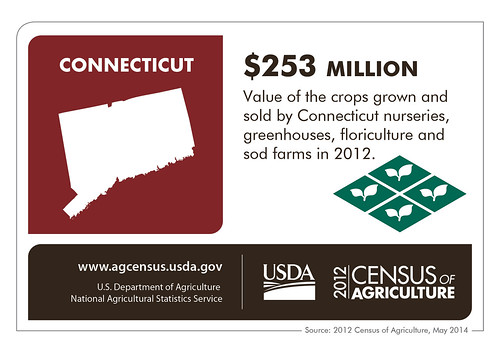
The Census of Agriculture is the most complete account of U.S. farms and ranches and the people who operate them. Every Thursday USDA’s National Agricultural Statistics Service will highlight new Census data and the power of the information to shape the future of American agriculture.
Connecticut may be the third smallest state in the Union, but it has a large agricultural presence, as the results of the 2012 Census of Agriculture showed.
Bucking the national trend, Connecticut farming has been growing for the past two decades. We now have nearly 6,000 farms, which may not seem like a lot, but it’s a staggering 60 percent increase from the 3,754 farms we had in our state in 1982. At the same time, our farmland acreage remained relatively stable, which means that the size of an average farm has been trending down. As of 2012, an average Connecticut farm is 73 acres.
The smaller farms suit our state just fine given our terrain, which ranges from mountains in the northeast to coastal areas along Long Island Sound. Our agriculture focuses on serving the needs of metropolitan areas of New York City; Hartford, CT; Providence, RI; and Boston, MA. More than 900 Connecticut farms harvested vegetables for sale in 2012, with bell peppers being the most popular crop. To meet the needs of East Coast home owners and landscapers, in 2012, 880 of Connecticut nurseries, greenhouses, floriculture and sod farms grew and sold almost $253 million worth of those crops. And we have livestock as well, with 774 farms in Connecticut raising cattle and calves. Most of the sales on the livestock end come from milk, however. In 2012, our farms sold nearly $70 million worth of milk from cows. Connecticut’s coastal area has hosted shellfish farms since Colonial times. In 2012, our aquaculture industry sold nearly $20 million worth of seafood, primarily shellfish from Long Island Sound.
When it comes to operators, women farmers have been an important part of our agriculture for several years. In 2012, more than 25 percent of all Connecticut farms were operated by women as principal operators. This is up from 23 percent in 2007. Overall the 2012 Census counted more than 3,700 women farmers in our state.
Connecticut farmers have also stepped up their efforts to get agricultural products into consumers’ hands. With the growing “buy local” movement, nearly a quarter of Connecticut farms market human food products directly to consumers. About 10 percent of the farms in the state now market their products directly to retail outlets such as restaurants, stores, and institutions; and at the same time, 218 of our farms participate in community-supported agriculture programs allowing local residents to partake in their harvest.
As you can see, farming in the small state of Connecticut is big.
